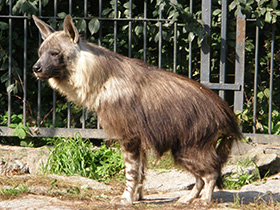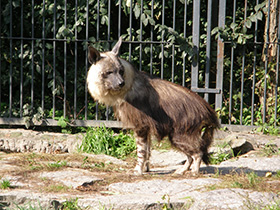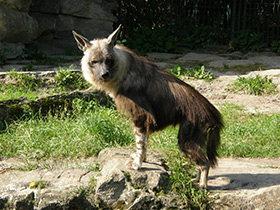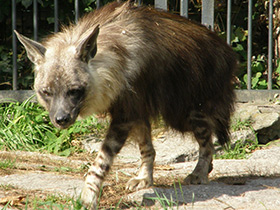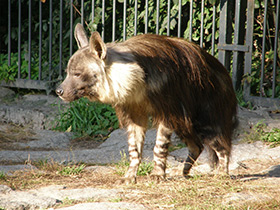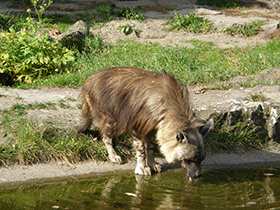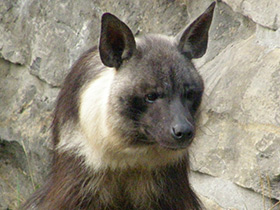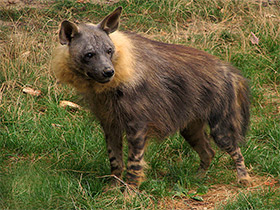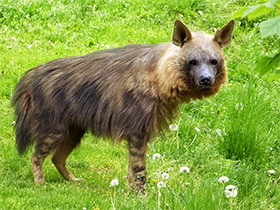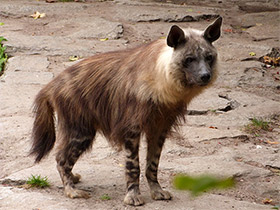The brown hyena or strandwolf (Parahyaena brunnea)
The brown hyena (Parahyaena brunnea), also called strandwolf, is a species of hyena found in Namibia, Botswana, western and southern Zimbabwe, southern Mozambique and South Africa. It is the only extant species in the genus Parahyaena. It is currently the rarest species of hyena. The largest remaining brown hyena population is located in the southern Kalahari Desert and coastal areas in Southwest Africa. The global population of brown hyena is estimated by IUCN at a number between 4,000 and 10,000 and its conservation status is marked as near threatened in the IUCN Red List.
Appearance and habitat area
The brown hyena (Hyaena brunnea) is a species of carnivorous mammal of the family Hyaenidae. Hyaena brunnea is much smaller than the spotted hyaena, measuring 86-150 cm in length and 70-88 cm at the withers. Hyaena brunnea does not differ significantly between the sexes, although males may be slightly larger than females, weighing 40-44 kg (rarely up to 60 kg). Hyaena brunnea is characterised by its extremely long, rough, uniform brown, unspotted mane, which hangs sideways from the back. This species inhabits the desert parts of the coastal areas of southern Africa and usually stays close to the sea.
Nutrition and particularities
Hyaena brunnea has powerful jaws: young animals can crush the leg bones of a small antelope in five minutes, although this ability deteriorates with age as the teeth wear down. Hyaena brunnea has an anal gland located under the base of the tail, whose secretions are applied to grass stems in every quarter mile of its territories, especially along the borders.
Hyaena brunnea feeds on carrion and marine excrement. It is the largest terrestrial animal whose diet consists mainly of carrion. Most of its diet consists of carcasses killed by large predators, although Hyaena brunnea may supplement its diet with rodents, insects, bird eggs and fruit.
Hyaena brunnea is an aggressive scavenger, often appropriating the carcasses of jackal, cheetah and leopard victims.
Social behaviour and reproduction
Hyaena brunnea live in clans of 4 to 15 individuals: pairs of adults and their young. There is a defined social hierarchy within the clans, which is maintained through aggressive ritual performances and mock duels. Female Hyaena brunnea usually have litters every 20 months. Usually only the dominant female mates, but if two young are born in the same clan, the mothers will nurse each other's young while paying more attention to their own. A litter usually consists of 1-5 pups, weighing about 1 kg at birth. Unlike the Crocuta crocuta, the Hyaena brunnea is born with its eyes closed and opens them at eight days of age. After three months of age, they leave their burrows. Unlike the Crocuta crocuta, all adult members of the clan bring food to the cubs. The cubs do not leave the vicinity of the den until they are 14 months old.
Threats and conservation status
The global brown hyena population is estimated to comprise 4,000 to 10,000 individuals. It is listed as Near Threatened in the IUCN Red List. The major threat to the brown hyena is human persecution, based on the mistaken belief that it is harmful to livestock. Farmers find brown hyenas scavenging on livestock carcasses and wrongly assume that they have killed their property. Brown hyena body parts are also occasionally used for traditional medicines and rituals. The brown hyena is not in high demand for trophy hunting.
There are several conservation areas that are home to the brown hyena, including the Etosha National Park in Namibia, the Central Kalahari Game Reserve in Botswana and the Kgalagadi Transfrontier Park. The maintenance of these protected areas aids in the conservation of these animals. Educational campaigns are being utilized to promote awareness about hyenas and dispel prevailing myths, while problem individuals are removed from farmlands and urbanized areas.

















